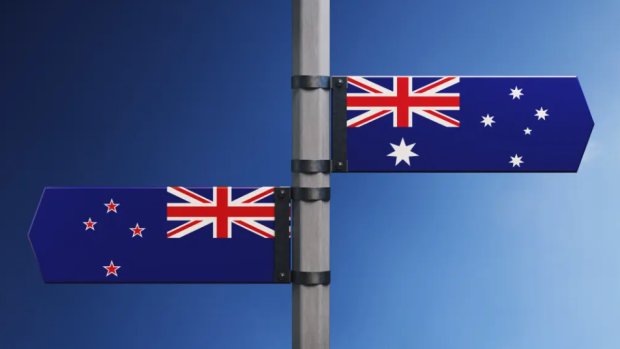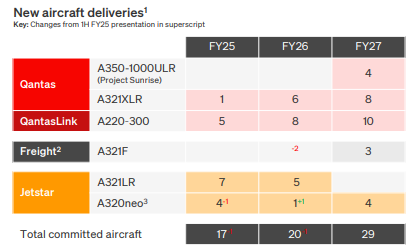Australasian airline update: earnings briefings reveal more about fleet strategies

With the three major Australasian airlines all releasing their annual results within a 24-hour span in 3Q2025, new details emerged that shed more light on their fleet and capacity plans.
Senior executives from Qantas, Virgin Australia and Air New Zealand had already shared a lot of information about their companies during the CAPA Australia Pacific Airline Leader Summit on 31-Jul-2025, prompting a recent two-part analysis of their plans: Australasian airlines make progress on fleet upgrades: part one - Qantas and Air Niugini; part two - Air New Zealand & Virgin Australia.
However, enough additional commentary came out of the earnings briefings that another update is warranted.
The major new development was Qantas almost doubling its firm orders for Airbus A321XLRs for its full-service fleet, with plans for a new cabin configuration. The airline also fleshed out the picture a little more regarding the launch of its 'Project Sunrise'.
Air New Zealand has bumped up its order for Boeing 787 widebodies, but in the shorter term it continues to face major issues due to aircraft availability.
Virgin Australia, meanwhile, is confident that its Boeing 737 MAX delivery stream will increase significantly in the current fiscal year, after slowing to a trickle in the previous year.
All three airlines were solidly profitable in the fiscal year 2025 - but, as usual, it was some of the other commentary that proved more interesting.
Fiscal year 2026 began on 1-Jul-2025 for the three airlines.
Summary
- Qantas has received its first two Airbus A321XLRs, and new deal boosts orders to 48.
- The airline will wait until it has three A350-1000ULRs before launching 'Project Sunrise' flights.
- Virgin Australia has already received four of the 13 Boeing 737-8s due in FY2026.
- Air New Zealand has boosted its widebody orders by converting two 787-10 options.
- The airline’s grounded aircraft total is not expected to drop significantly until FY2027.
New A321XLR orders will be configured for longer routes than its initial deliveries
Qantas announced that it had placed orders for 20 more A321XLRs, boosting its total to 48 aircraft. The latest orders were converted from options that were secured in previous deals.
The 20 A321XLRs in this follow-up order will be delivered from 2028. Sixteen of these will be configured with lie-flat business class seats - a first for a Qantas narrowbody type.
The A321XLRs with lie-flat seats will be used on transcontinental flights from Australia's east coast capitals to Perth, and on short haul and medium haul international flights.
Qantas has already taken delivery of two A321XLRs from its previous orders, and these are set to enter service in mid-Sep-2025 on the Sydney-Melbourne and Sydney-Perth domestic routes. They will then be progressively introduced on other routes.
The A321XLRs are intended to replace the Boeing 737-800s in the Qantas narrowbody fleet. The airline expects to have seven A321XLRs in its fleet by the end of its financial year on 30-Jun-2026.
So this means they will primarily be flying domestically, but will also be used on short haul international routes that are currently served by the 737s - and the A321XLRs' additional range will make new narrowbody routes viable too.
The airline is remaining coy about when and where the first of its A321XLRs will be deployed on international routes.
However, Qantas Group CEO Vanessa Hudson indicated that the A321XLRs could be used to "expand flying on existing routes into Southeast Asia, and open up new possibilities like Perth-India and Adelaide-Singapore".
The Qantas Group subsidiary Jetstar also has A321XLRs on order, and these are due to begin arriving from 2027.
Qantas delivery totals will progressively increase over the next two years
The Qantas group took delivery of 17 new aircraft of all types in FY2025, which ended on 30-Jun-2025.
It estimates that it will take delivery of 20 new aircraft in FY2026, and 29 in FY2027. Its deliveries during these two years will comprise 36 aircraft for Qantas, 10 for Jetstar and three for Qantas Freight.
Qantas planned new aircraft deliveries by model and group entity

Source: Qantas FY2025 earnings presentation.
The Jetstar A321XLRs are not included in this list, which may signal that they are due in the second half of calendar year 2027 (i.e. the first half of FY2028).
Qantas wants to have three of its modified A350s in service before starting Project Sunrise flights in early 2027
Details continue to emerge regarding Qantas' high-profile Project Sunrise launch.
During its results briefing, Qantas said that the first of its A350-1000ULRs for the Project Sunrise ultra-long-range flights is due to move to the Airbus final assembly line in Oct-2025, with deliveries set to start in Oct-2026.
Ms Hudson said the initial Project Sunrise flights will begin in the first quarter of the 2027 calendar year, after the airline has taken delivery of three A350-1000ULRs.
Qantas Group forecasts solid capacity growth across most of its units
In terms of capacity guidance, Qantas projects that the full-service carrier will see a 5% year-on-year increase in ASKs for its domestic operation, and 9% for international, in FY2026.
For Jetstar, domestic ASKs will be up by 7%, but international is expected to drop by 2%.
The Jetstar international numbers include Singapore-based Jetstar Asia, which was shut down in Jul-2025, and its aircraft redeployed elsewhere in the group.
Excluding the Jetstar Asia effect, Jetstar's international capacity would be up 12% in FY2026.
Virgin Australia hopes to make much more progress in its narrowbody fleet renewal this year
For Virgin Australia, one of the major themes of the current fiscal year is an expected dramatic increase in its Boeing 737-8 deliveries, which will help accelerate its fleet refresh.
The airline is scheduled to receive 13 Boeing 737-8s in FY2026, Virgin Australia said during its annual earnings briefing on 29-Aug-2025.
This would represent a significant increase from the single 737-8 it received in FY2025, and the six in FY2024.
Virgin Australia has already taken delivery of four of the 13 Boeing 737-8s due in FY2026, said its CFO Race Strauss.
Despite previous delays, the airline is "very confident" that it will receive the remaining nine before the end of the fiscal year, Mr Strauss said. Even if there was slippage in delivery times, the airline would not expect it to be significant, he said.
Like many other airlines, Virgin Australia has mitigated previous Boeing delivery delays by extending leases and wet-leasing aircraft for its domestic fleet.
The airline had 96 Boeing narrowbodies in its fleet as of 30-Jun-2025, comprising 79 Boeing 737-800s, nine 737-700s and eight 737-8s.
By the end of FY2026, Virgin Australia expects to have a total of 103 Boeing jets - in addition to the 13 Boeing 737-8 deliveries, the airline plans to phase out six 737-800s.
Virgin Australia's regional and charter subsidiary Virgin Australia Regional Airlines (VARA) is also refreshing its fleet.
VARA is due to take delivery of four Embraer E190-E2s in the current fiscal year, while retiring three Fokker F100s and two Airbus A320s.
The airline projects domestic capacity growth of 4% for the first half of fiscal 2026.
Air New Zealand has increased its 787 firm orders by 25% with its latest additions
Air New Zealand has boosted its widebody order book by exercising options for two more Boeing 787-10s, the airline revealed in its FY2025 results briefing on 28-Aug-2025.
The two additional aircraft mean that Air New Zealand now has orders for 10 Boeing 787s. Five of these will be 787-9s, and five will be 787-10s.
Two 787s are expected in the current fiscal year, three in FY2027, two each in FY2028 and 2029, and one in FY2030.
The first of the 787-10s is due for delivery in early 2028, so presumably all of the aircraft due after that will be 787-10s.
All of the airline's remaining 787 orders will be powered by GEnx-1B engines, in a change from the Rolls-Royce Trent 1000s that power its existing 787 fleet.
Air New Zealand's next two 787-9 deliveries are due in Feb-2026 and Mar-2026, and these will be in a new cabin configuration that will include the airline's innovative 'Skynest' product - this consists of six bunk beds that can be booked by economy class passengers for 4-hr sleep periods.
There is unlikely to be much improvement in Air New Zealand's grounded aircraft situation in this fiscal year
The airline currently has 14 Boeing 787s in its fleet - but some of these are grounded due to engine availability problems, that have kept up to 20% of its jet fleet out of service.
The airline has been hard-hit by the global engine maintenance bottlenecks, as it has Pratt & Whitney-powered Airbus narrowbodies, as well as Rolls-Royce-powered Boeing 787s.
Air New Zealand had up to 11 aircraft grounded at once during the second half of FY2025, comprising six narrowbodies and five 787s.
For the first half of FY2026, the airline predicts that it will have 9-10 aircraft grounded at any one time.
The airline expects to see gradual recovery in aircraft availability in FY2027, which begins 1-Jul-2026, and into FY2028, its CEO Greg Foran has said.
The majority of its grounded aircraft are expected to be returned to service by the end of calendar year 2027 (the first half of FY2027), and the airline estimates it will have only one widebody and one narrowbody grounded due to engine availability by the end of FY2028.
These forecasts are based on the airline's current assessment of engine maintenance timeframes.
Because of its fleet headaches, Air New Zealand has had to revise its medium term capacity growth forecasts, Mr Foran said.
The airline expects its system capacity to be up by 2%-4% in FY2026, which would move its capacity to 90% of pre-COVID-19 levels.
Air New Zealand now expects to overtake pre-pandemic capacity levels in its domestic and international networks in FY2028.
The airline has done what it can to reduce the effect of the groundings by leasing additional engines, and wet-leasing a handful of Boeing 777-300ERs.
The new deliveries will also help.


